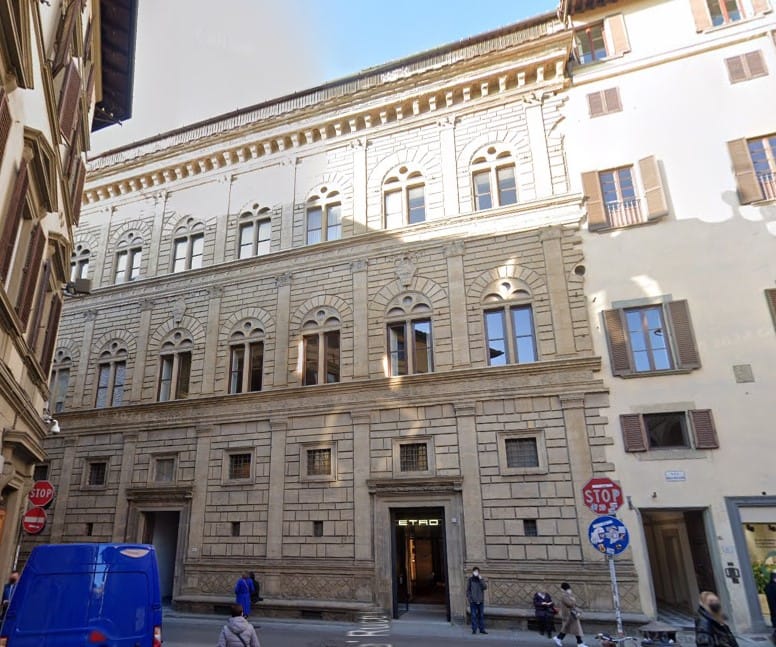

Hidden Details of Palazzo Rucellai — Walking through Florence’s centre is like crossing an open-air museum where every stone has a story. Beyond postcard views, subtle details escape the guidebooks but reward curious eyes. One is Palazzo Rucellai, Alberti’s elegant masterpiece on Via della Vigna Nuova. Today we skip its famous façade and focus on the Hidden Details of Palazzo Rucellai: the rusticated stones marked by tiny engravings and signatures left by craftsmen, and even the discreet wooden-framed doorbell beside the main entrance. These quiet clues make the Hidden Details of Palazzo Rucellai richer than any grand narrative.
Discovering the Palazzo Rucellai details in the Rusticated Stones
Firstly, when you look at the façade’s bugnato (rusticated stone blocks), you notice each block isn’t identical. Some have edges that are more worn, some are smoother; many bear small incision marks—mason’s marks—made by the stoneworkers or quarries. According to ArtTrav, there are 50+ incisions on the façade: stylized letters, numerals, stars, crosses.(ArtTrav) These aren’t graffiti; they are signatures, codes, or marks left by the craftsmen: “I was here, I shaped you.”
Moreover, the type of stone (pietraforte) and the way the rustication is treated differ depending on height: the lower levels are more robust and pronounced; as you go higher, the blocks are smaller, finishing smoother. This produces rhythm and also an illusion of lightness—as Alberti intended.(Wikipedia)
Understanding the Palazzo Rucellai details in Proportions and Classical Orders
Secondly, one of the main Palazzo Rucellai details is the careful use of classical orders: the ground floor (or basement) uses the Tuscan order, the piano nobile (noble floor) uses Ionic, and the upper floor uses a simplified Corinthian order. This superimposition recalls the Colosseum and reflects Alberti’s humanist study of ancient architecture.(Wikipedia)
Also, the façade is organized in three horizontal tiers, separated by string courses (marcapiano) and cornices, and vertically by pilasters. The use of a continuous bench at street level adds another classical reference and was also a social element: sitting and gathering.(isiflorence.org)
Hidden Functional and Modern Insertions among Palazzo Rucellai details
Transitioning from the ancient to the present, there are functional details often overlooked—like the doorbell. Tucked behind a wooden casing near the central door, a small, modest, technological artifact which seems almost apologetic among Renaissance stone. It’s not original, but it speaks of living history: that this building is not just to be admired from afar, but to be used, to be part of daily life.
Similarly, look for small iron rods or anchors that may have been used to fix or stabilize the stone cladding, especially where the stone faces are thin and attached over older structures. These structural details are subtle, often invisible unless you are close.
Why These details Matter for Appreciation
- They connect us to the craftsmanship. Every mason’s mark or irregular incision reminds us that this is human work, not “perfect” but shaped by hands, tools, time.
- They reveal Alberti’s theory made real. Proportions, orders, stone types—Alberti’s treatise De re aedificatoria argued for harmony over ornamentation; these details are where theory becomes material.
- They enhance legibility for tourists and scholars alike. For SEO and research (for example, if one searches “Palazzo Rucellai details”, “mason’s marks on Palazzo Rucellai”, “rustication Alberti Florence”), emphasizing these small features improves discoverability.
External References & Further Reading
Here are a few external links that go deeper into the architecture, history, and hidden details of Palazzo Rucellai:
- Smarthistory: Leon Battista Alberti, Palazzo Rucellai — rich visuals and architectural analysis.
- Wikipedia: Palazzo Rucellai — for general facts, context, and bibliography.
- ArtTrav: “Palazzo Rucellai: 6 Secrets of the Florentine House” — about the mason’s marks and mysterious glyphs.
- Britannica: Palazzo Rucellai — authoritative summary of Alberti’s work and Renaissance façade design.
Conclusion
So, the next time you pass by Palazzo Rucellai, don’t just look up and admire its grandeur—look down at the stones, at those tiny carved marks; look for the modest doorbell; observe how Alberti’s orders change lane by lane; notice the wear on some faces, the sharper edges on others. All these small marvels, all those Palazzo Rucellai details, are the soul beneath the façade. And perhaps, give a small nod to that shy little doorbell: a witness to centuries, whispering between past and present.



